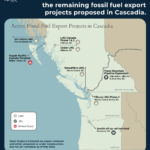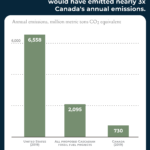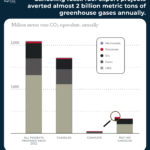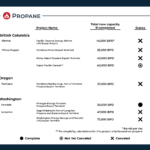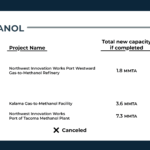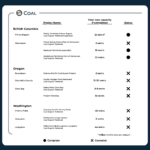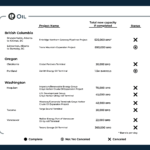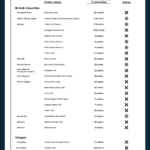By Emily Moore, Senior Researcher, Fossil Fuels Transition
Since 2012 fossil fuel executives from dozens of companies, including Kinder Morgan, Pembina Pipeline Corporation, and Enbridge, have schemed more than 50 large projects to export coal, oil, gas, or their derivatives from Cascadia’s coast in British Columbia, Oregon, and Washington.
But local communities, Tribes, environmentalists, and local governments rejected calls to turn Cascadia into a fossil fuel export terminal. Thanks to a combination of local opposition, see-sawing energy prices, and regulatory hurdles, project backers canceled 40 of those projects—a whopping 73 percent. Just 6 of all the proposed projects have been completed and are operational today.
Had all the once-proposed 55 projects gone ahead, it would have spelled disaster for the climate. Extracting, transporting, and burning the fuel associated with all the Cascadian fossil fuel export proposals would have spewed the equivalent of 2,095 million metric tons of CO2 into the atmosphere annually, roughly 30 percent of the entire annual greenhouse gas emissions of the United States and nearly three times the annual emissions of Canada. Instead, Cascadia averted 1,717 million metric tons of annual greenhouse gas emissions.
Cascadia cannot claim victory just yet. Nine projects are not yet canceled, eight of which are in British Columbia, as shown by the map and graphic below and detailed in Sightline’s new report. Of the remaining projects, the decade-long multibillion-dollar boondoggle to expand the Trans Mountain oil pipeline would be the single largest greenhouse gas emitter. If a livable future is something leaders in Cascadia are serious about, they will also relegate these remaining projects to history’s trash can.
Resources
- The full .pdf report
- All graphics from the report (.zip file or Google Drive), available for free use with attribution
- Downloadable, sortable spreadsheet of all projects listed in the report (Excel or Google Sheets), including name, location, fuel type, capacity, and status
- Press release about the report
- Live map of remaining fossil fuel export projects (Google MyMaps)



